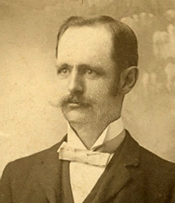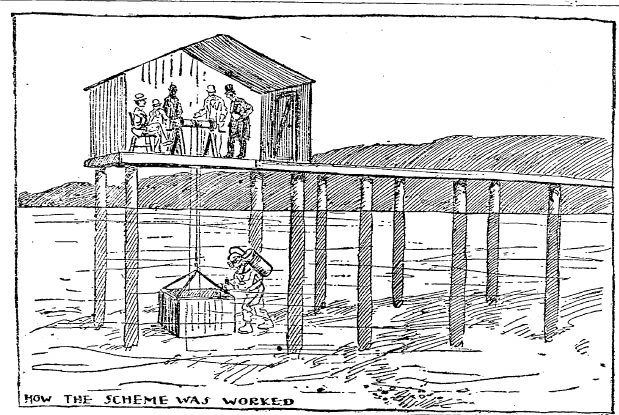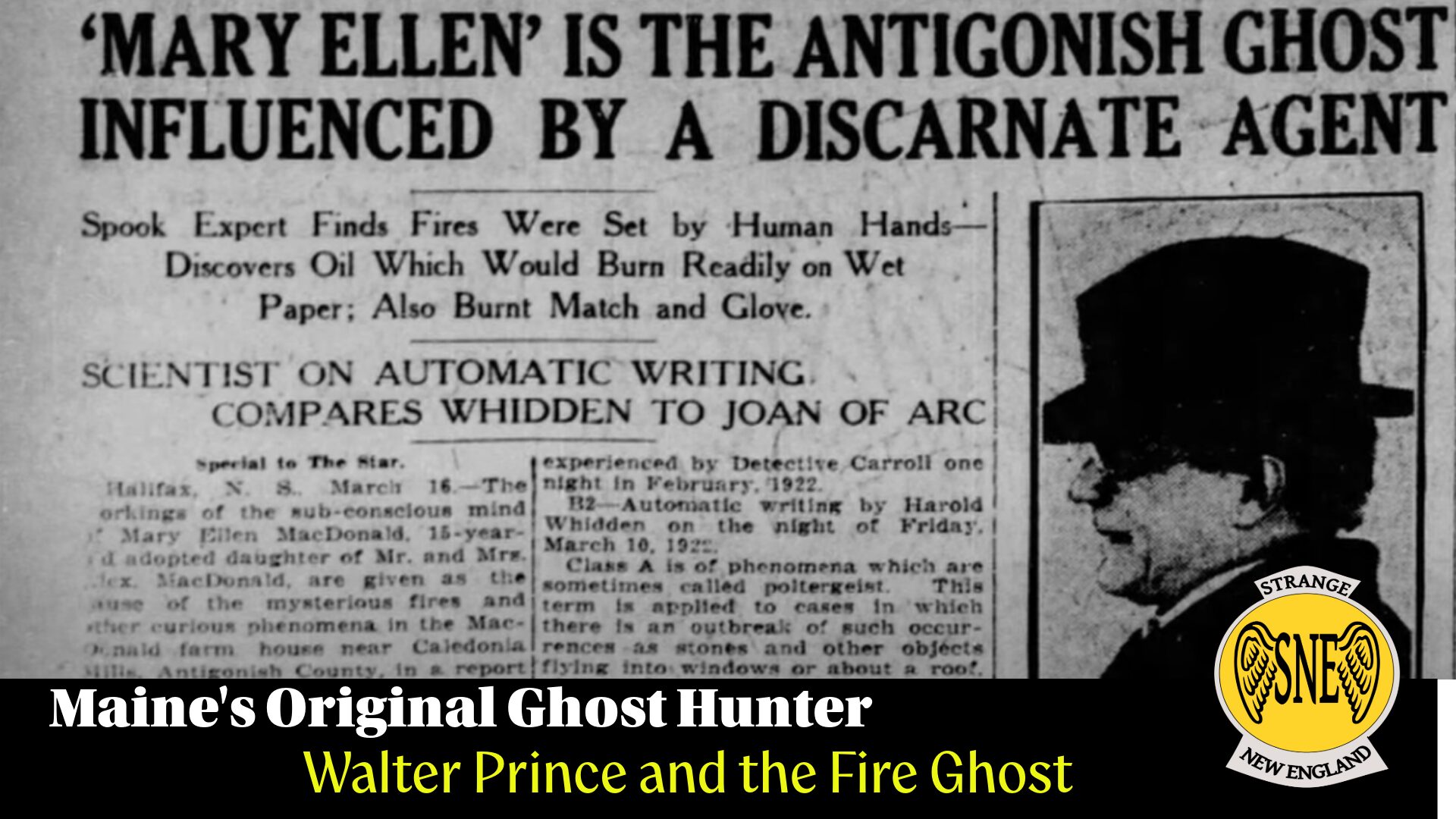
Gold forms in the heart of dying stars and as a result of their explosions, or novas, it is spread throughout the cosmos as one of the heavier elements. All the gold on earth no doubt came from such an explosion, just as all of the matter for all of the planets and the sun did, too. Maine does, in fact, have some gold in its ground, the first being struck in 1854 in Madrid and later, gold and silver were found in Acton, too. Gold can be found in deposits in the earth, but also dissolved in the waters of Earth’s oceans. Since 71 percent of the Earth’s surface is covered with water, it might make sense that all one needs to do is find a cheap way to extract that gold from the water to make a fortune. Maine is ideally situated for mining gold from water, if that was indeed possible, with its 3, 478 miles of coastline. But there is no method or invention to do the hard work of filtering out the gold. However, such a device was invented in 1897 and put into use in the small Maine town of Lubec. Why it worked and then, all of a sudden, didn’t work, is part of the strange history of New England.
Lubec, Maine is the northeastern-most town in the United States. It is closer to Africa than any other location in the country. With a population of 1,359 (2010 census), this community is situated on the very edge of things, snug next to Canada and only separated from it by the Franklin Delano Roosevelt Bridge, which spans the Lubec Narrows and leads to Campbello Island. Change comes creeping slowly to this Washington County hamlet, but sometimes, something comes along that summons a whirlwind of alternation in circumstances and acts to bring such small places notoriety and fame. Lubec had its moment in 1897 and became host to Maine’s one and only Saltwater Gold Rush.
To set the stage, one must remember that in 1897, science was beginning to take the main guiding role in the state of American life. In May of 1893, the World’s Fair, known as the Colombian Exposition, opened in Chicago. Thomas Edison had just invented the first motion pictures and in 1895, the White House Christmas Tree was decorated with Edison’s own light bulbs. The world had telephones and electric fans, Kodak cameras and zippers. Even people in far flung places like Lubec knew of such inventions because of the ubiquitous newspapers that gave such places a daily connection with the world at large. Great faith was put in industry and the power that steam, oil and now electricity promised would means that even one such industry for a small town might mean prosperity for all. Lubec was a fishing and lumbering village and people there lived a hard existence. It was into that setting in October of 1897 that a pair of men from Edgartown, Massachusetts arrived and set a plan into motion that would net them, in today’s money, over a million dollars and bring about financial disaster for investors throughout New England. It was a boom followed by the usual bust, but with a bit of wonder, too.
 Prescott Ford Jernegan, a Baptist minister, and his good friend Charles Fisher, rolled quietly into town one day and took up shop at an old grist mill at Mill Creek in North Lubec. The two had a business plan that, like most, required investors to open their pocketbooks and take a chance on what they assured people was a sure thing. We still have the prospectus for their enterprise, which they dubbed the Electrolytic Marine Salts Company, or EMS. Their claim was something that many people knew to be true – gold was in the water that flowed through Lubec Narrows. However, unlike anyone before them, they claimed to have hit upon a device that could use electricity and chemistry to grab the microscopic pieces of gold and accumulate it, and best of all, it could happen overnight, while the good people of Lubec and all of the investors slept. Everyone would go to sleep and then wake up in the morning much, much richer.
Prescott Ford Jernegan, a Baptist minister, and his good friend Charles Fisher, rolled quietly into town one day and took up shop at an old grist mill at Mill Creek in North Lubec. The two had a business plan that, like most, required investors to open their pocketbooks and take a chance on what they assured people was a sure thing. We still have the prospectus for their enterprise, which they dubbed the Electrolytic Marine Salts Company, or EMS. Their claim was something that many people knew to be true – gold was in the water that flowed through Lubec Narrows. However, unlike anyone before them, they claimed to have hit upon a device that could use electricity and chemistry to grab the microscopic pieces of gold and accumulate it, and best of all, it could happen overnight, while the good people of Lubec and all of the investors slept. Everyone would go to sleep and then wake up in the morning much, much richer.
Why Lubec? Why not Boston or New York? Jernegan answered investors with the fact that Lubec is on Passamaquoddy Bay which experiences some of the highest tides on the planet and as a result, more seawater rushes in and out of the narrows than out of any other harbor in the Northeast. When asked how a minister and not an inventor had come across the idea involved in the accumulator device, Jernegan claimed divine inspiration. God wanted him to build this device and share the wealth and sent him the entire idea in a ‘vision.’ Today, that alone might stop serious inventors from opening their checkbooks, but in 1897, not everyone was so suspicious of claims of divine visions. Such a connection might even serve to make it more of a sure bet for the investor. It didn’t hurt their enterprise to be surrounded by folk who had only a rudientary knowledge of electricity and and chemistry. There were fewer people to discover their duplicity.
The machine that he ‘invented’ to siphon gold from seawater is quite simple in its design. Imagine a large cast iron tub with two platinum rods inserted into a proprietary mixture of chemicals at the bottom. A battery supposedly ran the accumulator, along with the addition of some mercury. Other than that, all that was needed to collect the gold from the seawater was seawater itself. Twenty-four hours after lowering the accumulator into the water, it would be raised and little nuggets of gold would be found in the mixture – nuggets, not a film or specs of gold, but nuggets. That should have been the first clue that these two men were not what they purported to be and that this was a dubious device, indeed.
A battery supposedly ran the accumulator, along with the addition of some mercury. Other than that, all that was needed to collect the gold from the seawater was seawater itself. Twenty-four hours after lowering the accumulator into the water, it would be raised and little nuggets of gold would be found in the mixture – nuggets, not a film or specs of gold, but nuggets. That should have been the first clue that these two men were not what they purported to be and that this was a dubious device, indeed.
Imagine you are an investor. You have made the journey to Lubec, Maine, a rather long distance journey into the wilder regions, just to see if some crackpot invention really works. You are suspicious at first that such a thing is possible. But then you watch as the accumulators are lowered into the channel and at the same time the next day, you watch as they are pulled up and cracked open. There in front you is the proof that it is a sound investment – gold, in all of its glory. One after another, people with a bit of money to invest, or a lot of money, couldn’t give the pair of inventors money fast enough. It was simply too good to be true. Everyone wanted in on it.
Hundreds of local people were involved in the new industry – mining gold from seawater. Not that they were easily swayed. There is nothing like a downeast yankee for doubt and discovery, but they had the proof in front of their eyes and if that wasn’t enough, the newspapers they all read had articles claiming success in the venture. On January 5, 1898, a year after the EMS Company started business in Lubec, the Portland Transcript ran a story that resonated with the locals and investors.
“It is reported that gold and silver were taken from the sea water at North Lubec at the rate of $2 worth per hour, a few days ago, and that the company intends putting in two hundred machines of that capacity.”
That many accumulators cost money – platinum wasn’t cheap. Also, there were operating costs and investors had to be paid. As time passed, more and more money was needed to make the venture work. Over two hundred and fifty boxes at a time were being processed in the waters off Lubec. With the rumor that a new plant with five thousand boxes would soon be added to the company’s assets, stocks skyrocketed. In fact, an actual 900,000 shares of the stock were sold by that July. Over 800 men were working for the EMS company. It looked like the little town of Lubec was going to be put on the map as the first place on Earth were gold was successfully and profitably ‘mined’ from the sea. Chemistry, electricity, and invention were the new paradigm. They had replaced logging, fishing and farming with an exciting new industry.
But all good things must come to an end. When Fisher left for a business trip in late July of the next year, no one took much notice, but his absence was soon followed by Jernegan and his entire family. There was neither hide nor hair of the pair of inventors who had promised to make everyone investing in their plans rich beyond the dreams of Midas. The good people of the EMS company found that the accumulators no longer worked now that their inventors had absconded. The locals who worked for the company were paid their final paycheck but the investors were left holding the bag for all of their hopeful monetary dreams. It was, it seems, too good to be true, after all.
So what happened? Why didn’t the accumulators work anymore? Probably because they never actually worked in the first place. In later years, the pair of inventors who had successfully evaded justice by never coming back to America from their exile in places like Australia and the islands of the Pacific, had found themselves feeling somewhat guilty and returned some of the money, between $75,000 and $85,000, to some of their investors. How did they do it? Fisher was an adept diver, able to don a helmeted, weighted diver’s suit and make his way into the water under the cover of darkness to add small nuggets and chunks of gold to the accumulators. Every night, he added the same pieces of gold into the pots that were pulled out the next day. The problem they had was finding enough gold to put into the new additional accumulators. Like so many schemers, they let their initial success drive them forward too quickly to keep up with the demand. When they were beyond the failsafe point, they left. Their criminal act, for which they were never prosecuted, was the ruin of many investors up and down the East Coast. Fisher may or may not have died in Australia and Jernegan became a teacher in the far-flung Philippines, safe from prosecution. We know truly know what happened to either of them.
But in every dark cloud there is a silver lining. The EMS plant, now standing empty, proved to be the ideal place to implement another, new, far more lucrative industry, one that kept the families of Lubec safe from wolves at the door. It was converted for use as a sardine factory, an extremely lucrative venture for the town for a very long time to come. Gold from seawater? Well, not quite, but the dark schemes of two con artists set up the town of Lubec for another industry that became one of the town’s hallmarks.
By the way, if you can figure out a way to extract gold from the oceans, there’s a lot of it. Current estimates tell us that there are at least 20 million tons of it there, just floating around, not to mention gold beneath the ocean floor. However, be aware that the ocean is so dilute that the concentration of gold in it is measured in parts per trillion, or, more precisely, for every liter of seawater, there is about 13 billionths if a gram of the yellow stuff. Still, that’s enough gold to give every man, woman and child on earth nine pounds of it. Now, wouldn’t that be nice? By the way, if you’re ever in Lubec, stop by the Historical Society’s museum. They have a replica of the ill-famed accumulator set up for your inspection. Too bad it doesn’t really work.
SOURCES
http://lubec.mainememory.net/page/960/display.html
Is There Gold in the Ocean http://oceanservice.noaa.gov/facts/gold.html
Parker, Gail, It Happened in Maine: Remarkable Events That Shaped History, 2013, Globe Pequot Press,
Lubec Historical Society http://www.lubechistoricalsociety.com/
“Is There Gold in the Ocean?” http://oceanservice.noaa.gov/facts/gold.html




